Adagrasib targets an important oncogenic pathway so the tumour will find a workaround, even if the drug has a combo partner
Need to Know:
- Mirati’s adagrasib is under investigation in both non-small cell lung cancer and colorectal cancer, but it seems like it offers longer duration of response in lung cancer.
- Adagrasib is targeting a key oncogenic pathway in colorectal cancer, and so it will find ways to outsmart the drug. Combining adagrasib with Erbitux might help, but the cancer might still work around the combo.
Mirati Therapeutics’ MRTX849 (adagrasib) has experts wary if there is a possibility for the KRAS G12C inhibitor to extend its short duration of response (DoR) in metastatic colorectal cancer (CRC).
How well do you really know your competitors?
Access the most comprehensive Company Profiles on the market, powered by GlobalData. Save hours of research. Gain competitive edge.

Thank you!
Your download email will arrive shortly
Not ready to buy yet? Download a free sample
We are confident about the unique quality of our Company Profiles. However, we want you to make the most beneficial decision for your business, so we offer a free sample that you can download by submitting the below form
By GlobalDataThe targeted pathway is highly important for proliferation, so the tumour will find compensatory mechanisms to combat inhibition. The best combination partner to extend the durability of such RAS inhibitors is yet to be identified, experts added.
Adagrasib is under investigation in second-line (2L) CRC and beyond. In contrast to the DoR seen in non-small cell lung cancer (NSCLC) with KRAS G12C inhibitors, the DoR is much shorter in CRC. This may be due to blocked signalling pathways being re-established quickly due to their importance for cancer survival, or KRAS may have a different function in lung cancer versus CRC, experts said.
A Mirati spokesperson said the company expects CRC data in 2H from Phase I/II KRYSTAL-01 evaluating adagrasib monotherapy in patients who have received three or more lines of therapy, as well as in combination with Eli Lilly’s Erbitux in 2L. In 1Q, Mirati initiated its Phase III KRYSTAL-10 trial studying adagrasib plus Erbitux in 2L CRC patients.
Combo approach may help
Preclinical data support adagrasib plus Erbitux’s potential to improve efficacy. Both agents target different parts of the same signalling pathway. Still, experts questioned whether the combination would extend DoR to clinically significant levels, as the tumour would still likely develop resistance to both treatments. Erbitux monotherapy is not effective in KRAS mutant-positive patients.
While KRYSTAL-1 may reach its 20% overall response rate (ORR) target to be considered a success, durability data may still likely remain short. In KRYSTAL-10, improving upon chemotherapy cocktails FOLFOX and FOLFIRI, the trial’s active comparator arm, may be a high bar for the combination, especially if the chemotherapy arm overperforms in the progression-free survival (PFS) coprimary endpoint.
GlobalData analyst consensus forecasts adagrasib to reach $2.23bn in 2027 in sales in all indications. Mirati has a market cap of $8.22bn.
Durability not as long in CRC
KRAS G12C inhibitors like adagrasib do not appear to deliver durable responses in CRC compared to NSCLC, experts agreed. In KRYSTAL-1, of the two CRC patients in the Phase I/Ib portion, the first patient had a treatment duration of almost 25 weeks and the other had a treatment duration of around 12 weeks. In contrast, in Phase I/Ib NSCLC patients, treatment was ongoing at more than 11 months in four responders, according to a May company presentation.
The same trend can be seen with Amgen’s KRAS G12C inhibitor Lumarkas. In the Phase I/II CodeBreaK100 trial, the median PFS in NSCLC is 6.3 months, compared to four months in CRC. In November 2020, this news service reported Lumarkas and adagrasib lacked substantial enough differences to assign an advantage in NSCLC.
A monotherapy having a better durability in a different indication compared to CRC is not an unprecedented situation, experts noted. For example, BRAF inhibitor monotherapies have more durable responses in melanoma than in CRC, they added.
Targeting a valuable pathway
The current theory states suboptimal KRAS G12C inhibitor durability in CRC is due to the reactivation of the MAPK pathway the inhibitors are designed to block, explained KRYSTAL-10 investigator Dr Rona Yaeger, medical oncologist, Memorial Sloan Kettering Cancer Center, New York. These inhibitors work by keeping the KRAS mutation in an inactivated state, she noted. However, if enough of the mutation present in the cells becomes activated, the tumour resumes proliferation, she said.
However, KRAS may have a different function in CRC compared with NSCLC, noted Dr Ronald DePinho, professor, Department of Cancer Biology, University of Texas MD Anderson Cancer Center, Houston. In NSCLC, KRAS is the known as a gatekeeper gene, he said. Gatekeeper genes are directly linked to regulating tumour growth. In contrast, APC is the gatekeeper gene in CRC, and activated KRAS instead plays a role in disease progression and metastasis maintenance, he added. This means therapeutic extinction of activated KRAS G12C would benefit NSCLC but may have a minimal impact on the primary disease burden in CRC, he explained.
Dosing could help durable response
Adagrasib 600mg twice-daily dosing may result in a higher steady state concentration than Amgen’s Lumakras’ once-daily dosing, said CodeBreaK100 investigator Dr Marwan Fakih, professor, Medical Oncology and Therapeutics Research, City of Hope Comprehensive Cancer Center, Duarte California. Adagrasib’s dosing allows almost 100% inhibition of mutant KRAS over the entire dosing period, the spokesperson noted. More extensive tissue distribution helps ensure adequate levels of adagrasib reach dense or distant tumour cells, allowing for longer durability, the spokesperson added.
However, it is unclear if adagrasib dosing would be an efficacy edge, Fakih said. KRAS G12C inhibition hinges on a covalent bond, which lasts for 24 hours, he noted. As such, it is unclear if a twice-daily dosing is necessary as is done in KRYSTAL-10, he explained. Lumakras is approved as a 960mg once-daily drug.
EGFR inhibitor a possible partner
One way to potentially improve the duration of adagrasib is through a combination approach, experts said. Combining adagrasib with an EGFR inhibitor such as Erbitux is logical as the latter was also investigated in combination with BRAF inhibitors to help bolster its efficacy, noted Fakih. Yaeger pointed to preclinical data showing EGFR signalling as the major mechanism of CRC resistance to KRAS G12C inhibitors.
It is still unclear if durability would be extended with the combination approach, said Dr Axel Grothey, medical oncologist, West Cancer Center and Research Institute, Germantown, Tennessee. Both adagrasib and Erbitux target different parts of the same signalling pathway, and the pathway may find a workaround, he added. The HGF gene can be upregulated to activate the MET receptor on CRC cancer cells, enabling escape from EGFR inhibition, DePinho noted.
EGFR inhibitors such as Erbitux are not effective in KRAS mutant cells, which draws pause if it would provide a substantial duration benefit to the combination, DePinho said. Erbitux in combination with FOLFIRI was FDA approved in 2012 in frontline CRC, but specifically in KRAS mutation-negative patients.
More preclinical work needs to be done to understand what the best combination partner for KRAS G12C inhibitors in CRC would be, DePinho said. Targeting the APC pathway would be the most productive option, although effective agents have been elusive, he added. There is preclinical data supporting the combination of adagrasib plus an approach targeting SHP2, Yaeger noted. SHP2 is an oncogenic enzyme known to manage growth and survival signalling.
Risk of chemo overperforming
In KRYSTAL-10, adagrasib plus Erbitux has FOLFIRI and FOLFIX as active comparators. The trial has a PFS coprimary endpoint, and these chemotherapy cocktails offer a median PFS of five months in 2L, experts noted. It would be ideal if adagrasib plus Erbitux delivers a median PFS of 6–7 months for clinical relevance, at an improvement of 1–2 months over the comparator, said Dr Philip, medical oncologist, Karmanos Cancer Institute, Detroit, Michigan. However, PFS may be challenging to improve upon, especially if the active comparator arm delivers a higher-than-expected result, such as six months, Fakih explained.
Meanwhile, in KRYSTAL-1, the company indicated a 20% ORR with a DoR of more than four months was the benchmark for a potential accelerated approval. If this bar is reached, it would be a clinically relevant result because of the dearth of options available, Yaeger said. Of the approved therapies, the response rate is only 1% with a six-week DoR.
The 20% ORR target is achievable based on current experience with these inhibitors, but the DoR would be the main challenge to improve upon, Yaeger said. In KRYSTAL-1 data so far, the confirmed ORR is 17% (three out of 18 patients), with stable disease of 78% (14 out of 18 patients).
Favourable side effect versus chemo
Nevertheless, the possible edge for adagrasib plus Erbitux is the possibility it may have a relatively lighter side-effect burden compared with the chemotherapy cocktails, Fakih said. Adagrasib twice-daily dosing allows for better tolerability, the spokesperson added. However, DePinho noted this does not mean the combination does not have severe side effects. In KRYSTAL-1, 30% of treatment-related adverse events are Grade 3-4. Its most common side effects are nausea, diarrhoea and vomiting of any grade.
Amgen’s Lumakras is also under investigation in CRC in various trials as a monotherapy or in combination, with Phase II data coming this year, according to a June company presentation. As with NSCLC, it may be premature to compare assets with more data needed, experts agreed. Lumakras garnered accelerated approval in May based off CodeBreaK100 data in KRAS G12C-mutated NSCLC.
Reynald Castaneda is an Associate Editor for Clinical Trials Arena parent company GlobalData’s investigative journalism team. A version of this article originally appeared on the Insights module of GlobalData’s Pharmaceutical Intelligence Center. To access more articles like this, visit GlobalData.










Related Company Profiles
Eli Lilly and Co
Amgen Inc
Memorial Sloan Kettering Cancer Center
Mirati Therapeutics Inc